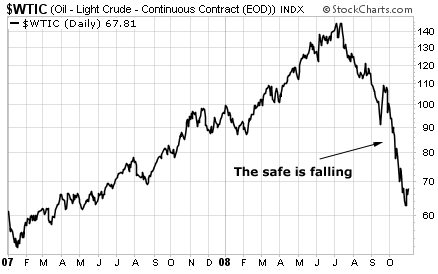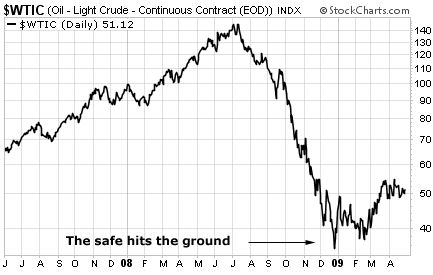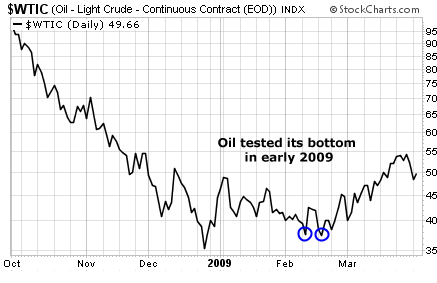But what if you find an asset that's a terrific value and has a
great bullish long-term argument for buying it... but it's locked in a
downtrend? You want to buy, but you don't want to "fight the tape."
Today, you'll learn how to safely take advantage of just such a situation.
The following chart displays a type of price move that has
bankrupted hundreds of thousands of people, so please pay careful
attention to it:
This is a chart of crude oil from early 2007 through late 2008. See
that huge, sharp decline on the right-hand side? That's a market in
crash mode. Some traders call this kind of move a "falling knife" or a
"falling safe."
Traders see this kind of fall and think, "It's getting cheap. It's
due for a big rebound... and I'm buying." They get a thrill from trying
to pick the exact bottom of a runaway market. They perform the necessary
fundamental analysis to realize a market is cheap after a big fall...
Armed with this valuation knowledge, they head out to the "front lines"
and go for glory.
They usually get riddled with bullets.
Here's why: Whether an asset is undervalued simply doesn't matter
during these moves. So saying things like, "This stock is just so cheap"
is only going to get you and your money in trouble. It's going to get
you into risky trades.
There's a much lower-risk way to trade these moves. It's a lot
easier on your blood pressure... and more profitable. Let's consider
more advice from master trader Marty Zweig.
Zweig says trying to buy an asset in freefall is like trying to
catch a falling safe. You'll always get squashed. His alternative is
amazingly simple and profitable:
Don't try to catch a falling safe. Wait for it to hit the ground... Then just walk over and pick up the money.
Let's look at crude oil again. Instead of trying to catch the
falling safe by going long crude oil in October 2008 when the chart
looked like this...
... the smart speculator waits for the safe to hit the ground. He waits for the chart to look like this:
See that price action in late 2008? Traders who bought oil at $70
in October got a 50% "discount" from July's high of $140. They also lost
half their money as the safe kept falling and falling. It eventually
hit the ground at $35 in December.
The low-risk time to go long crude oil and oil stocks came in
February 2009. Something important happened on February 18 and again on
February 23.
After hitting a low of $35 a barrel in December, oil rebounded into
the upper $40 range. The oil bears countered this rally and tried to
drive prices back down to the low. Their efforts were the strongest on
February 18 and February 23. Each time, oil refused to go back to its
December low. As traders would say, oil "tested" its bottom. Take a
look...
At this point, it was much safer to buy oil than it was in October
2008. Anyone who went long back then was buying into a sharp decline.
Traders who waited on a bottoming out process – and waited for the
safe to hit the ground – made a bundle as oil went on to rally into the
$70s and $80s in 2009.
This strategy of avoiding sharp declines allows us to stand safely
aside as the safe hits the ground and spills out its contents. It's a
classic method of buying value that's worked for hundreds of years...
and will work for hundreds more.
Good trading,
Brian Hunt









